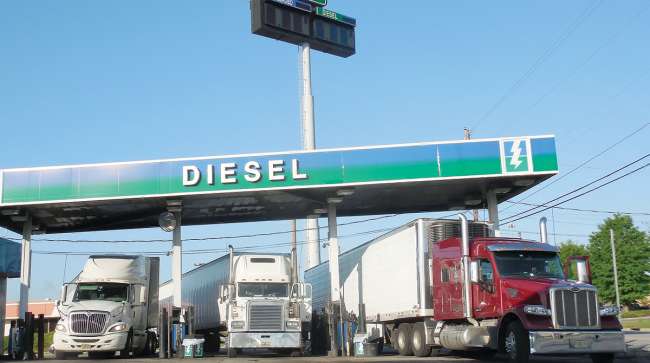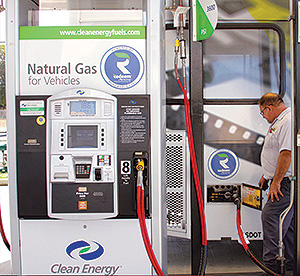Senior Reporter
Diesel Inches Higher to $3.163 a Gallon

The U.S. average retail price of diesel rose 0.3 cent to $3.163 a gallon, the Department of Energy reported, while crude climbed to $63.14, the highest level in almost three weeks amid opposing supply-and-demand signals.
Diesel costs 11.4 cents less than it did a year ago, DOE said May 20.
U.S. average #diesel fuel price on 5/20/2019 was $3.163/gal, UP 0.3¢/gallon from 5/13/19, DOWN 11.4¢/gallon from year ago https://t.co/vmBwyifYCS #truckers #shippers #fuelprices pic.twitter.com/3tUKrqjKEw — EIA (@EIAgov) May 21, 2019
Regional diesel prices were unchanged in two areas, lower in two others and higher in six. The top price was in California, where diesel climbed 0.9 cent to $4.145 a gallon. The lowest price was in the Gulf Coast region where it rose 0.2 cent to $2.907.
Also, the national average price for regular gasoline fell 1.4 cents to $2.852 a gallon, DOE’s Energy Information Administration said.
The national average is 7.1 cents lower than a year ago, EIA said.
Regional average gasoline prices also were mixed, falling in seven areas and climbing in two.
“We are starting to plateau not just for diesel but for gasoline as well. Oil prices have backed off from some of the recent highs. We should probably trickle a bit lower,” said Denton Cinquegrana, chief oil analyst at Oil Price Information Service.
“What I am finding interesting is oil prices over the past couple of weeks have been in this really tight range. That has given the retail market the opportunity for prices to flatten out.”
“We are just waiting for the next move,” he added.

A technician fuels with Redeem. (Clean Energy Fuels Corp.)
In related news, UPS Inc. agreed to purchase renewable natural gas from Clean Energy Fuels Corp. over seven years. Clean Energy said it’s the largest commitment ever by a U.S. company for the alternative fuel.
UPS will purchase 170 million gallon-equivalents of Redeem brand renewable natural gas, through 2026 — a move they expect will be a catalyst for broader adoption of the fuel.
UPS ranks No. 1 on the Transport Topics Top 100 list of the largest for-hire carriers in North America.
“Renewable natural gas and renewable diesel are kind of the new trends,” Cinquegrana said, “and there is obviously great demand for them. In California they generate Low Carbon Fuel Standard credits, and those credits are worth quite a bit right now — not at record highs, but pretty darn close, about $200 a metric ton.”
The credits can be sold to another obligated party that does not have enough credits for the emissions they generate.
The UPS vehicles fueling at 18 company-owned and -operated natural gas stations across 12 states will realize a significant reduction in greenhouse gas emissions, as much as 1,074,000 metric tons of GHG over the life of the agreement, according to Atlanta-based UPS.
Today we are announcing the largest purchase ever of #renewable natural gas in the U.S. This commitment will play a key role in advancing our goal to reduce absolute #GHG emissions 12% across our global ground operations by 2025. #RNG — UPS (@UPS) May 22, 2019
Redeem RNG yields at least a 70% reduction in life cycle greenhouse gas emissions when compared to conventional diesel or gasoline, Clean Energy reported — based on the weighted average carbon index of Clean Energy’s fuel supply as approved by the California Air Resources Board.
“The world has a trash problem. And the world has an emissions problem. Renewable natural gas, produced naturally from bio sources such as landfills and dairy farms, not only turns trash to gas, but it turns it into clean gas,” Mike Casteel, UPS director of fleet procurement, said in a release. “Since RNG is supported by existing national infrastructure used to transport natural gas, it’s a winning solution that will help UPS to reach our ambitious sustainability goals.”
UPS reported it has used more than 28 million gallons of RNG in its ground fleet since 2014. Under the new agreement, it will use 22.5 million to 25 million gallon-equivalents per year.
UPS intends to make alternative fuel consumption be 40% of total ground fuel purchases by 2025, supporting its efforts to reduce the absolute greenhouse gas emissions of its ground fleet 12% by 2025.
West Texas Intermediate crude futures on the New York Mercantile Exchange closed at $63.10 per barrel May 13, compared with $61.04 on May 13.
Investors digested conflicting supply-and-demand signals. For the moment, they were won over by Saudi Energy Minister Khalid Al-Falih’s push for the OPEC+ coalition to “stay the course” on output curbs. Yet, ongoing tensions between the United States and China have kept price rallies limited, according to Bloomberg News.
“You’ve got some conflicting influences on the market and the price action today is pretty indicative of that,” Tyler Richey, co-editor at Sevens Report Research in Palm Beach Gardens, Fla., told Bloomberg. “The OPEC headline was a positive, although not necessarily a huge change versus expectations, and the trade-war risks are definitely a negative.”




